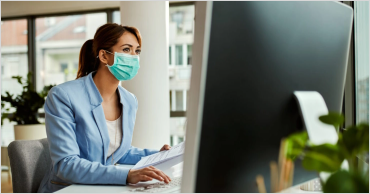Covid-19: Returning to Work
When its time to open up again for business, there are a number of considerations to take into account, but the most important is personal safety.
Do you recall the safety demonstrations on flights? The attendant is sure to inform you that when travelling with companions, should there be a loss of air cabin pressure you are to put that mask that pops down from the ceiling on first before helping your companion. This philosophy is something to heed at a time like now. Take care of yourself first so that you can take care of others. If you don’t take care of your own health and safety you will not be able to help your patients or be there for your loved ones. Putting yourself at jeopardy and taking unnecessary risks is not an option.
In occupational health and safety this is referred to as taking ‘every reasonable precaution’. For you, this will mean having the right personal protective equipment (PPE) to perform your tasks. Determining the right equipment is based on a risk assessment completed by the employer. Covid-19 requires us to re-visit our PPE needs and be extra vigilant in its use. At this time, this is stressful as the PPE supply chain is uncertain and difficult to predict. Before arriving to work be prepared with an adequate quantity of NIOSH-approved N95 respirators and be fit tested and trained on each model to ensure a proper seal to the face.
Personal Protective Equipment
Across the country there has been a shortage of PPE. Industries including construction and retail are wearing more PPE and different kinds of PPE than they have in the past. A case can be made from every industry perspective, and especially for emergency services and essential services, regarding why PPE is needed by their workers so that they can safely perform their work. But there is simply not enough supply to meet demand. Yet, if we are all going back to work, we still need to protect ourselves. In the near-term, this creates some challenging times ahead.
KN95 – A Special Note
KN95 masks hit the North American market when the CDC permitted them for respiratory protection when only NIOSH-approved respirators were allowed previously. This was in response to product shortages. As a result, there has been some skepticism about the efficacy of KN95s especially as some are not designed for medical use and counterfeit products have entered the market. Given the price point of some of these products, purchasing unsuitable KN95 masks could be a costly mistake.
When performing respirator fit testing, both the brand (or manufacturer) and model number must be identified on the fit test record. This is not always readily available to the KN95 user. KN95 masks with ear loops, not straps, also fail fit tests more frequently. Given the increased cost of PPE beware of paying too much and purchasing product that is not suitable for the type of work that you do.
The CDC website provides information including a list of approved respirators sorted by manufacturer.
Opening Up for Business
In preparation, there may be a number of other organizational tasks to complete prior to opening up for business.
• Determine and communicate to workers the date of re-opening so that personal affairs can be arranged.
• Identify any worker accommodations.
• Decide on the method, frequency and criteria, pre-screening the health of returning workers shall be conducted to determine their wellness and ability.
• Assist workers on how they can safely travel to work ie. safe public transit tips, off-peak hours of travel, etc.
• Identify office hours and gauge if operations will be longer or shorter, on-peak or off-peak, etc.
• Establish staggered work hours to adjust to the new norm of social distancing.
• Ensure physical separation within office space and common areas.
• Organize foot traffic in one-way directions if possible.
• Clearly identify to visitors expectations on where they are permitted including washrooms.
• Clarify how deliveries are to be received safely.
• Eliminate clutter including magazines and toys in waiting areas.
• Remove fabric furniture and décor such as chairs and window coverings where biological aerosols are present.
Procedures
Your employer, or as the business owner, you should establish new or revised written procedures in response to Covid-19. These may include:
Personal protective equipment requirements and protocols. Ensure that this includes the correct donning, doffing and sequencing of PPE. Practice with staff on general use especially when handling unfamiliar equipment. Incorrect usage of PPE is a leading cause of illness. Ask for feedback to make improvements.
Be clear on re-usability of PPE. Disposable equipment is meant for one-use only. Follow manufacturer’s instructions and association and government guidelines. Infection, prevention and control protocols should be maintained.
Patient and visitor procedures including pre-screening of patients and guests, accompanying attendants, and the implementation of physical distancing including sanitization and PPE requirements, if necessary.
Physical distancing should be encouraged and controlled through work scheduling to reduce contact, staggered sanitation periods, bathroom breaks, lunch hours and time spent in common areas.
Employment Law
Whether an employer or employee, make sure you understand your options when returning to work. Refusing to return to work when your employer asks you to return to work is complicated during these times. Communicate any concerns or obstacles and work out next steps collaboratively. Check your employment contract, follow the laws of Ontario and consult with an employment lawyer, if needed, to understand your options.




